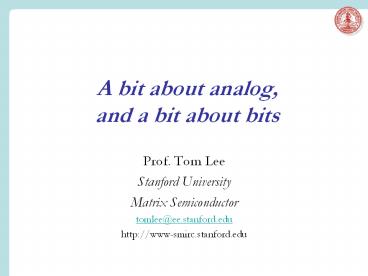A bit about analog, and a bit about bits - PowerPoint PPT Presentation
Title:
A bit about analog, and a bit about bits
Description:
Title: Acoustical Imaging Using Capacitive Micromachined Ultrasonic Transducer Arrays: Devices, Circuits, and Systems Author: Omer Oralkan Last modified by – PowerPoint PPT presentation
Number of Views:156
Avg rating:3.0/5.0
Title: A bit about analog, and a bit about bits
1
A bit about analog,and a bit about bits
- Prof. Tom Lee
- Stanford University
- Matrix Semiconductor
- tomlee_at_ee.stanford.edu
- http//www-smirc.stanford.edu
2
What is analog, anyway?
- Analog quantities such as voltage, temperature,
and pressure span a continuum of values. - Signals can range from, say, WiFi microvolts to
power line megavolts. - Analog systems typically evince high
functionality per unit power consumed (e.g., the
human ear consumes tens of microwatts), but - Difficult to process and store analog signals
faithfully. - Analog functions are usually highly specialized
typically cant readily convert one analog
circuit into another one. - Nature is analog.
3
What, then, is digital?
- Digital signals are discrete in amplitude and in
time - Signals are of uniform amplitude, say.
- Digital systems typically consume high power per
function, but - Storage and replication may be performed
essentially without error. - Digital systems can be quite flexible.
- Paradoxically, this property has killed off
circuit design innovation. - Digital is unnatural.
4
Analog vs. digital A false dichotomy
- Analog processing of some kind is unavoidable at
interfaces with the physical world. - No such thing as an all-digital radio, for
example (despite the buzz about software
radios). - Digital processing is a powerful and flexible way
of transforming, storing, conveying and
regenerating information. - Cant expect a 100th-generation photocopy to
resemble the original, but a 100th-generation
CD-ROM can be just as good as the master. - Analog and digital are good at quite different
things. - Explains why the arc of history has traced an
increasing synthesis of these two.
5
Increasing symbiosis through the ages
6
Increasing symbiosis through the ages
7
Increasing symbiosis through the ages
8
Another 3-D imaging with 2-D CMUTs
9
What you can do with a CMUT
Mechanically scanned transducer Analog processing
2-D electronically scanned array Massive digital
processing
10
So, (why) is analog ascending?
- Purely digital paradigms are limited.
- The Pentium 4 consumes 100W, the human brain but
25W.
11
Biology has thrown down the gauntlet
Source Hans Moravec, CMU
12
Whither analog?
- One view Analog will serve as merely another
rationale for Intel to build ever-more powerful
CPUs. This co-dependency will continue until
market forces dictate otherwise. - Another view Insights gained from studying
diverse fields will inform, and drive, a
convergent evolution of seemingly disparate
technologies. - Hard to predict where this will go, but my guess
is that ethicists and social scientists will have
plenty to chew on.
13
Man is the only computer that can be
mass-produced by unskilled labor.
-Wernher von Braun, rocket scientist































